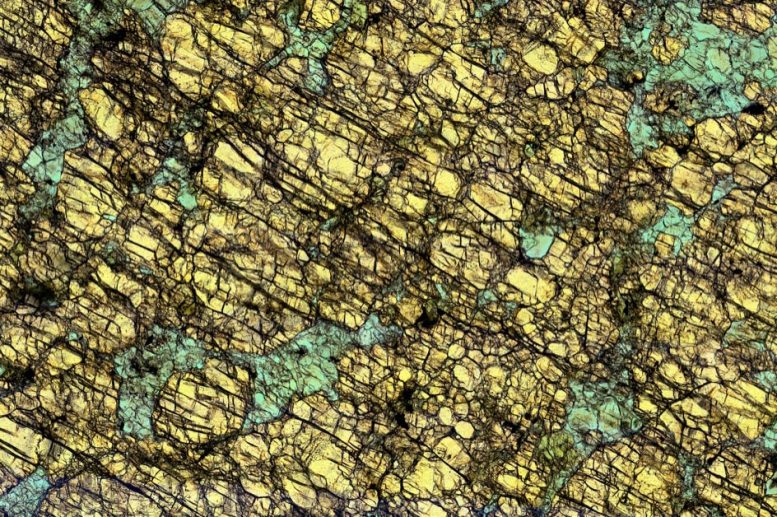
Microscope photograph of a lower arc crustal rock used in the study showing minerals of garnet (red) and clinopyroxene (green). Credit: Courtesy of the researchers
Magma Beneath Tectonic Collision Zones Is Wetter Than Previously Thought
New research findings may help explain how Earth’s crust forms, the location of ore deposits, and why some volcanoes are more explosive than others.
A new study has discovered that colliding continental plates may draw down more water than previously thought. The results could help to explain the explosiveness of some volcanic eruptions, as well as the distribution of ore deposits such as copper, silver, and gold. The research was conducted by geologists at the Woods Hole Oceanographic Institution (WHOI), MIT, and elsewhere.
The findings are based on an analysis of ancient magmatic rocks recovered from the Himalayan mountains — a geologic formation that is the product of a subduction zone, where two massive tectonic plates have crushed against each other, one plate sliding beneath the other over millions of years.
Subduction zones can be found around the world. As one tectonic plate slides beneath another, it can take ocean water with it, drawing it deep into the mantle, where the liquid can merge with rising magma. The more water magma contains, the more explosive an eruption may be. Subduction zones, therefore, are the sites of some of the strongest and most destructive volcanic eruptions in the world.
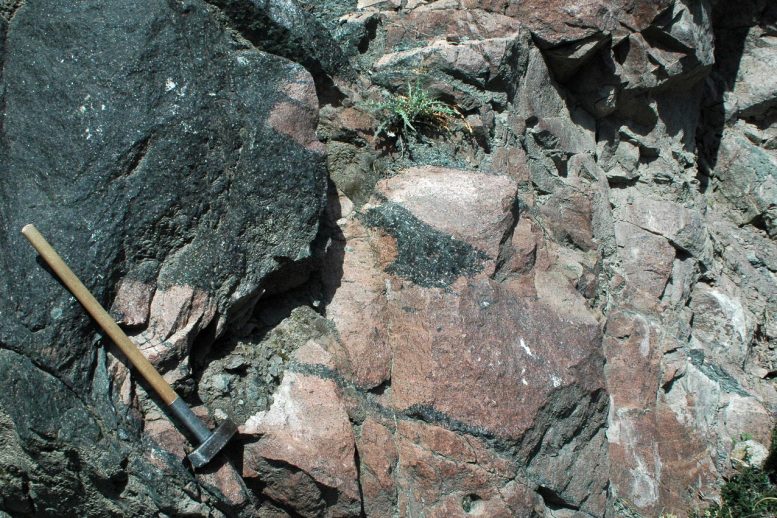
Rocks rich in the minerals garnet (red) and amphibole (black) from the Kohistan paleo-arc, similar to samples analyzed in the present study (hammer shown for scale). Credit: Courtesy of Othmar Müntener
Their analysis, published on May 26, 2022, in the journal Nature Geoscience, finds that magma at subduction zones, or “arc magmas,” can contain up to 20 percent water content by weight — about double the maximum water content that has been widely assumed. The new estimate suggests that subduction zones draw down more water than previously thought, and that arc magmas are “super-hydrous,” and much wetter than scientists had estimated.
The study’s authors include lead author Ben Urann PhD ’21, who was a graduate student in the MIT-WHOI Joint Program at the time of the study (now at the University of Wyoming); Urann’s PhD advisor Véronique Le Roux of WHOI and the MIT-WHOI Joint Program; Oliver Jagoutz, professor of geology in MIT’s Department of Earth, Atmospheric and Planetary Sciences; Othmar Müntener of the University of Lausanne in Switzerland; Mark Behn of Boston College; and Emily Chin of Scripps Institution of Oceanography.
Deep bends
Previously, estimating the amount of water drawn down in subduction zones was done by analyzing volcanic rocks that have erupted to the surface. Scientists measured signatures of water in these rocks and then reconstructed the rocks’ original water content, when they first absorbed the liquid as magma, deep beneath the Earth’s crust. These estimates suggested that magma contains about 4 percent water by weight on average.
But Urann and Le Roux questioned these analyses: What if there are processes the rising magma undergoes that affect the original water content in a way that scientists did not anticipate?
“The question was, are these rocks that rose quickly and erupted representative of what’s really going on down deep, or is there some surface process that skews those numbers?” Urann says.
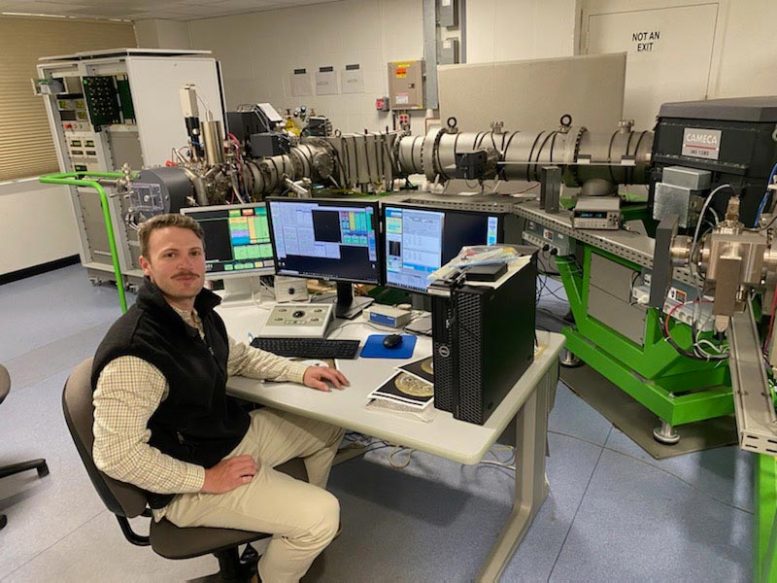
Benjamin Urann, who graduated from the MIT-WHOI Joint Program in 2021 and is now a NSF postdoctoral fellow at U of Wyoming, analyzes water in minerals with a secondary ion mass spectrometer at the Woods Hole Oceanographic Institution. Credit: Benjamin Urann
Taking a different approach, the team looked to ancient magmatic rocks called plutons, that remained deep beneath the surface, never having erupted in the first place. These rocks, they reasoned, would be more pristine recorders of the water they originally absorbed.
Urann and Le Roux developed new analytical methods by secondary ion mass spectrometry at WHOI to analyze water in plutons collected previously by Jagoutz and Müntener in the Kohistan arc — a region of the western Himalayan mountains comprising a large geologic section of rock that crystallized long ago. This material was subsequently upheaved to the surface, exposing layers of preserved, unerupted plutons, or magmatic rock.
“These are incredibly fresh rocks,” Urann says. “There is no evidence of the rocks’ crystals being disturbed in any way, so that was the driver for using these samples.”
Urann and Le Roux selected the freshest samples and analyzed them for signs of water. They combined water measurements with the composition of minerals in each crystal and plugged these numbers into an equation to back-calculate the amount of water that must have been absorbed originally by magma, just before it crystallized into its rock form.
In the end, their calculations revealed that the arc magmas contained an original water content of more than 8 percent by weight.
The team’s new estimates may help to explain why volcanic eruptions in some parts of the world are stronger and more explosive than others.
“This water content is key to understanding why arc magmas are more explosive,” says Cin-Ty Lee, professor of geology at Rice University who was not involved in the research. “The water content of arc magmas is a bit of a mystery because it’s so hard to reconstruct original water content. Most of the community uses [erupted volcanic rock], but they are far removed from their deep sources. So, if you can go straight to the mantle, that is the way to go. The [rocks in the current study] are as close as one can get.”
The results also may point to locations in the world where ore deposits — and high concentrations of copper, silver, and gold — might be found.
“These deposits are thought to form from magmatic fluids — fluids which have separated from the initial magma, which carry copper and other metals in solution,” Urann says. “The problem has always been that these deposits require a lot of water to form — more than you get from magmas with 4 percent water content. Our study shows that super-hydrous magmas are prime candidates to form economic ore deposits.”
Reference: “High water content of arc magmas recorded in cumulates from subduction zone lower crust” by B. M. Urann, V. Le Roux, O. Jagoutz, O. Müntener, M. D. Behn and E. J. Chin, 26 May 2022, Nature Geoscience.
DOI: 10.1038/s41561-022-00947-w
This research was supported by the National Science Foundation and the Woods Hole Oceanographic Institution Ocean Venture Fund.

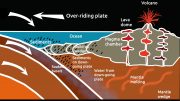
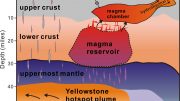



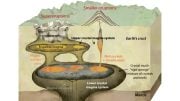
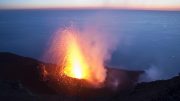
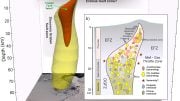
“The findings are based on an analysis of ancient magmatic rocks recovered from the Himalayan mountains — a geologic formation that is the product of a subduction zone, where two massive tectonic plates have crushed against each other, one plate sliding beneath the other over millions of years.”
–> This is a confusing statement. Subduction is indeed when one plate slides under the other, but the Himalayas are not a result of a subduction zone, but a convergent zone, where 2 plates collide (crush against each other) and create an uplift (the mountains).
That is confusing, but not entirely incorrect. Before the Indian plate collided into the Eurasian plate, they were separate by oceanic crust, which was consumed via a subduction zone beneath the Eurasian plate. Some of the rocks that formed during the existence of the subduction zone were preserved and incorporated into the mountains, and are the rocks they analyzed for this study. But I agree, to simply state that the Himalayan mountains is the product of a subduction zone is strange.